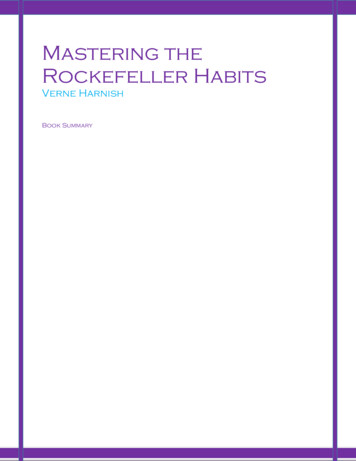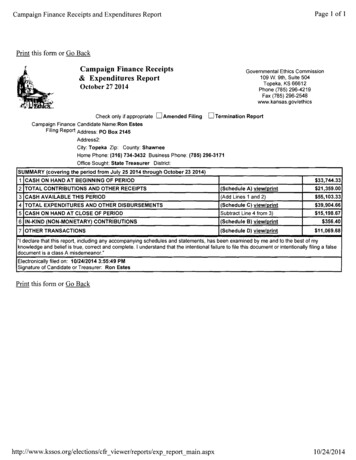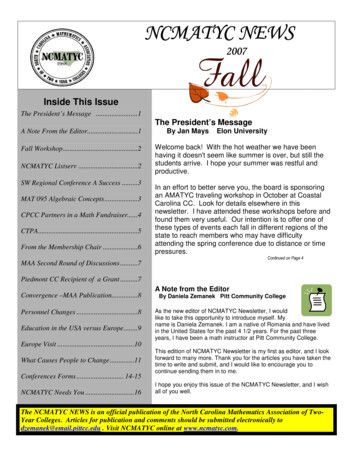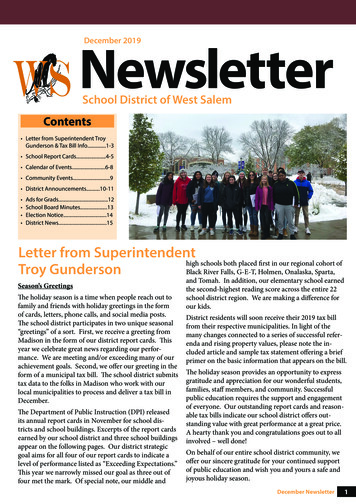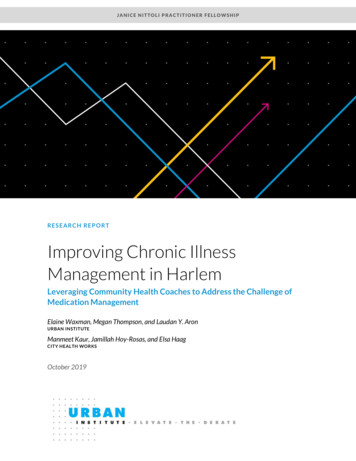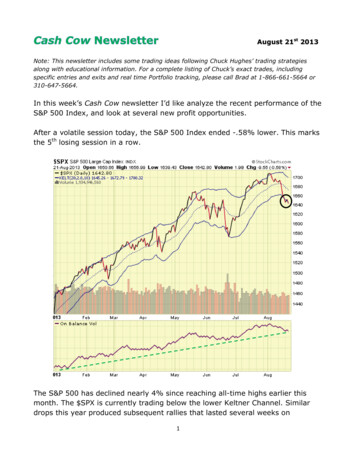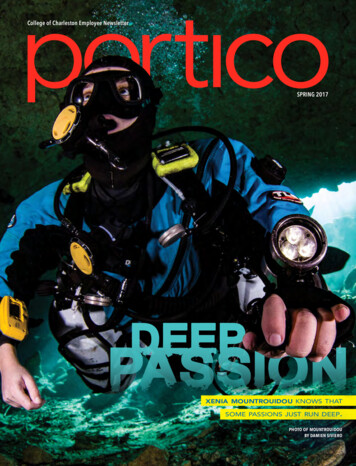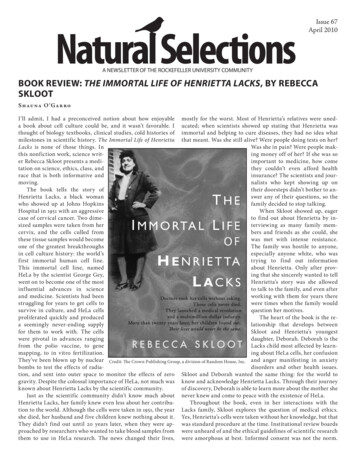
Transcription
Issue 67April 2010A NEWSLETTER OF THE ROCKEFELLER UNIVERSITY COMMUNITYBook Review: The Immortal Life of Henrietta Lacks, by RebeccaSklootS h au na O ’ Ga r roI’ll admit, I had a preconceived notion about how enjoyable mostly for the worst. Most of Henrietta’s relatives were uneda book about cell culture could be, and it wasn’t favorable. I ucated; when scientists showed up stating that Henrietta wasthought of biology textbooks, clinical studies, cold histories of immortal and helping to cure diseases, they had no idea whatmilestones in scientific history. The Immortal Life of Henrietta that meant. Was she still alive? Were people doing tests on her?Lacks is none of those things. InWas she in pain? Were people makthis nonfiction work, science writing money off of her? If she was soer Rebecca Skloot presents a mediimportant to medicine, how cometation on science, ethics, class, andthey couldn’t even afford healthrace that is both informative andinsurance? The scientists and jourmoving.nalists who kept showing up onThe book tells the story oftheir doorsteps didn’t bother to anHenrietta Lacks, a black womanswer any of their questions, so thewho showed up at Johns Hopkinsfamily decided to stop talking.Hospital in 1951 with an aggressiveWhen Skloot showed up, eagercase of cervical cancer. Two dimeto find out about Henrietta by insized samples were taken from herterviewing as many family memcervix, and the cells culled frombers and friends as she could, shethese tissue samples would becomewas met with intense resistance.one of the greatest breakthroughsThe family was hostile to anyone,in cell culture history: the world’sespecially anyone white, who wasfirst immortal human cell line.trying to find out informationThis immortal cell line, namedabout Henrietta. Only after provHeLa by the scientist George Gey,ing that she sincerely wanted to tellwent on to become one of the mostHenrietta’s story was she allowedinfluential advances in scienceto talk to the family, and even afterand medicine. Scientists had beenworking with them for years therestruggling for years to get cells towere times when the family wouldsurvive in culture, and HeLa cellsquestion her motives.proliferated quickly and producedThe heart of the book is the rea seemingly never-ending supplylationship that develops betweenfor them to work with. The cellsSkloot and Henrietta’s youngestwere pivotal in advances rangingdaughter, Deborah. Deborah is thefrom the polio vaccine, to geneLacks child most affected by learnmapping, to in vitro fertilization.ing about HeLa cells, her confusionThey’ve been blown up by nuclear Credit: The Crown Publishing Group, a division of Random House, Inc. and anger manifesting in anxietybombs to test the effects of radiadisorders and other health issues.tion, and sent into outer space to monitor the effects of zero Skloot and Deborah wanted the same thing: for the world togravity. Despite the colossal importance of HeLa, not much was know and acknowledge Henrietta Lacks. Through their journeyknown about Henrietta Lacks by the scientific community.of discovery, Deborah is able to learn more about the mother sheJust as the scientific community didn’t know much about never knew and come to peace with the existence of HeLa.Henrietta Lacks, her family knew even less about her contribuThroughout the book, even in her interactions with thetion to the world. Although the cells were taken in 1951, the year Lacks family, Skloot explores the question of medical ethics.she died, her husband and five children knew nothing about it. Yes, Henrietta’s cells were taken without her knowledge, but thatThey didn’t find out until 20 years later, when they were ap- was standard procedure at the time. Institutional review boardsproached by researchers who wanted to take blood samples from were unheard of and the ethical guidelines of scientific researchthem to use in HeLa research. The news changed their lives, were amorphous at best. Informed consent was not the norm.
It was seen as natural that tissue sampleswould be taken from patients and used intesting; some researchers even injectedtheir patients with cancer cells to see whatwould happen. There was, and in manyways there still is, an idea that workingtoward the greater good overrides theneed for a patient’s consent. Skloot doesnot offer her own opinion on this subject.Instead, she simply provides the information in a way that allows the reader tosee the situation from both sides: as a researcher trying to help the world and as apatient who feels that some part of themhas been stolen.Skloot is excellent at characterization; despite the vast array of personalities in the story, none of the charactersseem contrived or one-dimensional. Sk-loot not only achieves her goal of teaching the world about Henrietta Lacks, shealso introduces you to a host of peoplewhose stories will stay with you long afterthe last sentence is read. She manages totake several stories (a young woman fromsouthern Virginia whose cervical cellswould change the world; a girl who yearnsto know who her mother was; researchers and their amazing scientific advancements; a family that sought to understandhow someone could be dead and yet immortal) and weave them into one epic andmasterfully told tale.After learning about Henrietta Lacks,you’ll lament the fact that it took so longfor her story to get told, but you’ll be gladthat Skloot, who obviously cares deeplyabout her subject, was the one to tell it. A Very Brief History of Cell CultureEditorial BoardEDITORIAL BOARDJeanne GarbarinoCarly GelfondMelina HermanAdria Le BoeufJoseph LunaAileen MarshallEugene MartinEngin OzertugrulTobias ReichenbachSusan RussoJeff SmithJessica eller.eduJe a n n e Ga r ba r i noThe story of Henrietta Lacks and her (unknowing) contribution to the advancement of science has recently been resurrectedwith the publication of The Immortal Life of Henrietta Lacks (reviewed in this issue). Despite the clear disenfranchisement of theLacks family, HeLa cells have helped to revolutionize science aswe know it. As someone who frequents a tissue culture hood on adaily basis, this book really sparked my curiosity about cell culturein general. Yes, I know what we do with cells today when usingthem as a model system to investigate numerous processes relatingto health and disease, but how did it get to be this way? In this briefarticle, I hope to summarize some of the scientific breakthroughsthat have brought us to both present day tissue culture theory andpractice.The principles of cell culture began over 100 years ago whenthe German zoologist Wilhelm Roux showed that the neural platefrom chicken embryos could be removed and maintained in warmsaline solution for several days1. This novel concept was taken onestep further by Ross Granville Harrison, an American born scientist and Yale professor who, in 1906, not only maintained amphibian nerve fibers ex vivo, but also developed conditions under whichthese nerve fibers were able to proliferate2. The groundwork laiddown by Harrison was built upon by Nobel Prize winning scientistAlexis Carrel who, at our very own Rockefeller University (thenknown as the Rockefeller Institute for Medical Research), was ableto culture the heart of a chicken embryo for a period much longer than the normal lifespan of a chicken3. In fact, this experimentwas quite sensational considering that this heart was kept alive for34 years and actually outlived Dr. Carrel himself! These findingshelped convince other scientists that in vitro experiments usinganimal cells were entirely possible and, thus, could be consideredthe cornerstone of tissue culture.For the next several years, it was mainly tissue explants thatwere used for experimentation. However, due to the pioneering efforts of Katherine Sanford and colleagues, the concept of creatinga population of cells from a single cell came to fruition4. In addi-2tion, Harry Eagle sealed the fate of the future of cell culture in 1955by demonstrating that the tissue extracts used to grow cells couldbe replaced with a synthetic and defined nutrient mixture containing amino acids, vitamins, carbohydrates, salts, and serum5. Takentogether, these technologies paved the way for a whole new approach to scientific investigation using in vitro systems includingmutagenesis, cloning, and transformation. But, perhaps the largestimpact on society, was the ability to use cell lines to grow purifiedviruses for vaccine production.The idea that pure cell lines could be established and maintained indefinitely was finally concrete. These established celllines mimicked, at least in part, the major functional and metabolic characteristics displayed by the cell from which they wereoriginally obtained. Scientists were then able to study the cellularprocesses specific to particular organs and/or tissues with greaterease. Some examples of the cell lines established during this timewere adrenal cells, pituitary cells, neurons, myocytes, and hepatocytes6. As more and more cell lines were “born,” scientists realized that each cell type required a specific nutrient mixture foroptimal growth. Additionally, it was being discovered that serumcould be replaced with specific proteins, hormones, and/or growthfactors. As a result, experimental design became more complexand researchers began to ultra-specialize. As we all are aware, it isnot uncommon for scientists to spend their entire careers studyingone, or even one aspect, of a specific protein or pathway. This islikely how this came to be the norm.The next major advancement in the history of cell culture occurred in the 1970s with the development of hybridoma cell lines,which could be used for the production of monoclonal antibodies7. This technology was developed by Cesar Milstein, Georges J.F. Köhler and Niels Kaj Jerne and resulted in an equally sharedNobel Prize in Medicine in 1984. Jumping ahead to the late 1990s,a time frame more in line with my own scientific existence (I wasin kindergarten in 1984), we see the advent of stem cell biologyand the associated bioethical debate. In my personal opinion, the
enormous medical and commercial value as it relates to stem cellsmakes this a non-issue, but I digress from the point of this article.In 1998, stem-cell research was catapulted forward by the work ofJames Thomson (University of Wisconsin at Madison) and JohnGearhart (Johns Hopkins University) who, independently of oneanother, pushed the limits of science by successfully growing human stem cells in culture. Currently, stem cell research is still inits adolescence and our understanding of how we can actually apply stem cell technologies is mediocre at best, although there aresome very innovative (and inspiring) ideas out there. The hope, atthe very least, is to generate entire tissues to aid in the treatment ofsome of the most devastating diseases. For example, scientists areworking to generate insulin-producing pancreatic cells that can beused to cure type 1 diabetes.What is on the horizon for tissue culture? Well, I would assume that the ultimate goal is to actually grow entire organs ororgan systems. Is this even possible? Could transplant lists becomea thing of the past? As this is being written, devoted researchersare trying to generate novel ways to utilize stem cells for improving human health. It is quite possible that we will see, in our veryown lifetimes, the generation of new cardiac tissue to be used inheart attack victims and the ability for cancer patients undergoingchemotherapy and/or radiation treatments to receive replacementbone marrow and blood cells. Tissue engineering is the wave ofthe biomedical future. It was only one century ago that WilhelmRoux maintained the first cells ex vivo. Considering where we arenow, compared to the humble beginnings of cell culture, I do notforesee a negative impact on this inertia (barring any catastrophesresulting in major funding issues). Who knows, maybe we will seea breakthrough so instrumental that we will actually be around tosee what will happen a hundred years from now. Now that’s trulybecoming immortal. References:1. Hamburger V. Wilhelm Roux: visionary with a blind spot. J Hist Biol.1997 Summer;30(2):229-38.2. Nicholas JS. Ross Granville Harrison, 1870-1959. Yale J Biol Med. 1960Jun;32:407-12.3. Carrel A. On the Permanent Life of Tissues Outside of the Organism.J Exp Med. 1912 May 1;15(5):516-28.4. Sanford KK, Earle WR, Likely GD. The growth in vitro of singleisolated tissue cells. J Natl Cancer Inst. 1948 Dec;9(3):229-46.5. Eagle H. Nutrition needs of mammalian cells in tissue culture. Science. 1955 Sep 16;122(3168):501-14.6. Mather JP, Roberts PE. Introduction to cell and tissue culture :theory and technique. New York: Plenum Press; 1998.7. Wade N. Hybridomas: the making of a revolution. Science. 1982 Feb26;215(4536):1073-5.New York to Ban Coffee?E ugen e M a rti nare just as innocuous as putting a “BurnCalories, Not Electricity” sign at the entrances of our elevators, the centerpieceof this well-intentioned campaign is, unfortunately, an effective banning of coffee,Red Bull, and other highly caffeinenateddrinks. The only discussed alternative,which is levying a heavy sin tax on caffeinated beverages, is almost as bad.There have beenboth local and national criticisms ofthe plan, most notably and vocallythrough Rush Limbaugh, who stated,“This is Obamasocialism at work,folks. The government is telling youwhat you can andcannot put in yourbody.” Nonetheless,the nyc Health Department seems intent on ignoring thesecriticisms. In a press release, the Commissioner of the nyc Health Departmentstated, “Caffeine is an unregulated drugthat negatively impacts the lives of millions of New Yorkers. In an effort to con-tain current and future health care costs,as well as improve the quality of life ofmillions of New Yorkers, we will aggressively pursue limiting caffeine consumption.”Caffeine is not an evil; it is a friend.It has been reported to lower the risks ofdiabetes, Parkinson’s disease, and cavities. It also helpedmake this article,and countless experiments, possible.That said, the nycHealth Departmenthas been effectivein getting legislation passed. Withthe “NYC, Get SomeSleep”campaignhaving a proposedstart date of April1, 2010, those of uswho love the blackgold need to contactour representativesimmediately (with the author’s hope thisissue of Natural Selections comes out ina timely fashion). For more informationabout the campaign, and information onhow to prevent the caffeine ban, pleasevisit: http://tiny.cc/oMBsb. Cartoon by Rossana HenriquesIf an apple a day keeps the doctor away,can a really big apple help stave off a national health crisis? This much can be said:the big apple is trying. Ever since the NewYork City Health Department successfullybanned trans fats from being served innyc restaurants in 2006, it has been on amission to legislate New Yorkers towardsbetter health, with the hope that the effectsare national in scope. Given the influenceof nyc, it may even succeed.But that is also what makes the nycHealth Department’s next move, a pushto limit the caffeine consumption of NewYorkers, so frightening. First, a disclaimer: I love coffee. I need coffee. For me, aday without coffee seems more like a 16hour morning. This is why the nyc HealthDepartment’s recent proposal to limit caffeine in nyc beverages to no more than 23mg per liter, which is lower than the concentrations found in some decaffeinatedcoffees, feels like a personal attack.The proposed campaign, jarringlynamed “nyc, Get Some Sleep,” is meant tolimit the health consequences of insomnia and poor sleep, including poor weightregulation, depression, and impaired immune function. While many aspects ofthis campaign, such as offering rebatesif New Yorkers upgrade their mattresses,3
The Bobby Wagner Walk: A Waterfront Escape at our DoorstepJe ssic a Wr ight4It is easy to forget that New York City is an island. This word conjures always someone along this stretch enjoying the park and its waterfrontup images of sun-drenched beaches and waterside cafés. When standing views.in Midtown, surrounded by tall buildings and scaffold covered walkThe exit from the park is marked by a curved descent that ends atways, isle is the last descriptive term that comes to mind. There are many a ferry landing, re-depositing you alongside the river and the fdr. Aplaces in the city, however, where Manhattan is easily appreciated for winding red brick road marks the 1.5 mile mark and passes next to thethe island it is. At South Street Seaport the tall-ships, departing ferries, Asphalt Green Gym. From here there is a half-mile semi-circle stretchand the sadly retired Fulton Fish Market bring one back in time, to nyc that extends to 99th Street. This is my favorite section of the trail. Alas the bustling port city it once was. Along the waterfront trail on the though you are still alongside the fdr, the traffic here is less noticeable.Hudson River there are cruise ship docks, kayak rentals, and even wa- Instead, the arc of the trail enhances the closeness of the river and framesterfront cafés. Continue on past thea view that changes dramatically asGeorge Washington Bridge and thethe weather shifts. Heading north,view across the river changes fromthis stretch of river feels wilder, withcondominiums to wild cliffs. Uponly the nostalgic green of the Ranhere the smell of the sea is strongerdall’s Island Bridge behind it; whileand more appropriate, and it no lonon my return, the tall nyc buildingsreappear in the distance, welcomingger seems so surprising that whalesme home.will occasionally bump up againstManhattan’s shores.This stretch of trail is also, apparBut there is another place, a littleently, the best place to catch a fish. Inthe summer several fishermen standcloser to home, where nyc feels morelike an island than a sky-scraperagainst the railings, their lines arching long into the water below. In thefilled metropolis: the Bobby Wagner Walk along the East River fromwinter they are replaced by migrat63rd to 125th Street. This path wasing diving ducks, a group of Buffleheads. Bobbing in the water andbuilt in 1939, at the same time as thefdr, and is the oldest section of thequickly disappearing into the depthsto fish, these ducks serve as a link toManhattan Waterfront Greenway.Access to the trail sits right at ourthe Boreal forests and Arctic tundradoorstep, between Rockefeller Uniwhere they spend their summers.Year-round, cormorants join theversity (ru) and Scholar’s residence.The proximity and noise of the fdrducks and fishermen, while freighters lumbering by alongside remindcan easily deter the casual walker,but for runners and bikers seekingus that the sea cannot be far away.out a traffic-free path, and for dogThe next half-mile (to slightlybeyond the 110th Street Pier) is desowners looking for leash-free dogparks, it is a treasure. This trail hasolate in winter, but is a social hubon warm summer evenings. Thesebecome an integral part of my runs,both for its convenience and because Bobby Wagner Walk at 99th Street—cell phone picture, taken while running. nights the pier is filled with familiesit is a beautiful route in its own right.gathering for barbeques, while thePhotograph provided by the authorbenches play host to musical groups,I have never run in the dark, but Ifeel safe traveling it alone at all other times of day (from dawn till dusk) from bongo players to saxophonists. Beyond the pier, the trail continuesand throughout the winter it has remained accessible, even after heavy on to 125th Street, ending 3.5 miles from the start. This stretch feels moresnowfall. My usual run is just as the sun is setting, making the most of lonely and remote, and is generally devoid of trail-users, including mythe last light of the day.self. At 125th Street a chain link fence marks the end of the route. BikersProbably the least appealing stretch of this pathway is the first mile can link to the Triborough Bridge from here, and I have been told thatfrom campus, which may be why many easily dismiss the whole route. a hole in the fence allows adventurous runners to trail-blaze north, butThis section is narrow, passes by industrial buildings and under scaf- this is where my experience ends.folding, and is the closest to the cars. But, once you reach the mile markWhen I reach this fence, I turn into the wind that blows steadily upat 81st Street, a flight of stairs takes you away from the fdr and into Carl the river and chase the last of the light as I head for home. The streetlightsSchurz Park (for bikers there is a tire channel on the right side of the gradually blink on, and the 59th Street Bridge becomes increasingly scestairway). Once on top of the highway, the traffic below is easily forgot- nic, lit up against a twilight sky. I run to the end of the path, stretchingten. There are playgrounds, a small-dog park, and benches for read- by the newly renovated dog park, enjoying the contagious joy of dogs ating, kissing, skateboarding, photo-shoots, bird-watching, nursing, and play, and then head back across the bridge to York Avenue. Standing atknitting—all of which I’ve encountered at one time or another. In the the top of this walkway, with my home on the left and my work to thesummer there are even film screenings and concerts here, organized by right, I take the time to appreciate that nyc is an island, and that a waterthe Park’s Association. No matter the weather or the time of day, there is front run is always available to me—just outside my front door.
New York State of MindThis Month Natural Selections interviews Holly Hunnicutt, Administrative Assistant in the Laboratory of Neural Circuits and Behavior.Country of Origin: United States1. How long have you been living in NewYork? Over five years. I never thought Iwould live in nyc, but I wanted to stay withmy amazing and brilliant Head of Lab whenwe moved here from ucsf, and she was kindenough to bring me along.2. Where do you live? Astoria, Queens.3. Which is your favorite neighborhood? St.Mark’s Place, and also a Greek neighborhoodin Astoria along 31st Street and Ditmars Boulevard.4. What do you think is the most overratedthing in the city? The horse rides in CentralPark. They take you on a five-minute ride for 50.00, and subject the horses to constantdanger and sheer terror due to the traffic. Thepark sidewalks are nasty with horse poop, andpigeons eating from the horses’ feed buckets.Just terrible to expose people to this, not tomention the poor horses. -And underrated?The mom and pop stores that still exist andadd so much character and variety to nyc. Ipatronize them whenever I can.5. What do you miss most when you areout of town? My birds—Junebug, Buzzz andPookie.6. If you could change one thing about nyc,what would that be? Dial the Bloomberg machine back several notches.7. Describe a perfect weekend in NYC. Itwould have to include giving back some ofmy good fortune to one of my activist passions: lately it’s been mainly health insurancereform and environmental conservation. Iwould want to go to a comedy club, where Irepeatedly laugh until I gasp, and definitelywant to eat an amazing authentic NorthernItalian dinner at Barbetta Restaurant (ownedby Laura Magiolio & Günter Blobel). Then,some live music in a small venue with goodacoustics: I’ll see just about any kind of music,from the symphony to bluegrass. Also I gottahave some time to just sit, relax and wigglemy toes.8. What is the most memorable experienceyou have had in nyc? Taking my niece Olivia, who is from a small town in Virginia, toeat in the garden at Barbetta. We were treatedlike royalty, the décor was enchanting, andthe food was exquisite. Olivia was wowed bythe experience and said she felt like a star. Itwas a magical night.9. If you could live anywhere else, wherewould that be? San Francisco, San Diego,Santa Cruz, or Big Sur, CA. Abroad wouldinclude Naples, Italy or outside Paris, France.Or in a bird preserve or rain forest in CostaRica or Belize; developing eco-tourism inthreatened bird habitat.10. Do you think of yourself as a New Yorker? Absolutely, but with one caveat: I couldnever be that hostile commuter who won’tgive my seat on the subway to a pregnantwoman or disabled person. -Why? I have always been a sincere person, but I can comeacross somewhat gruff (my nickname in thelab is “der Labordrachenschatz”, or “the LabDragon”). The people I meet in New York respond well to that. Some of my best friendsthrough the years are New Yorkers, althoughmost of them have relocated to warmer climates. As individuals, New Yorkers are survivors: strong, and truly caring people. Thatworks for me. DVD CornerB er n i e L a ngsIf you enjoy documentaries touching on musical performancesthat are not simply concert films, there are currently two very goodmovies in stores and for rent.In his movie It Might Get Loud, Davis Guggenheim, who directedthe environmental film An Inconvenient Truth, reminds of us that rockand roll can, and should be, about love of craftsmanship and a deepappreciation of music’s history, The film focuses on interviews withand the music of Jimmy Page of Led Zeppelin, The Edge of U2, andJack White of The White Stripes. Representing three generations ofgifted guitarists, they discuss how their love for the guitar grew fromchildhood and how they struggled in their early years to find not justsuccess, but to make their own statement to add to the legacy of theblues and rock and roll. I have always felt that Jimmy Page has maintained the integrity of the legacy of his mighty band, and he comesacross as having never lost his enthusiasm for his instrument and hisfavorite artists from the past. I was very surprised at how well JackWhite handles himself in the presence of his great peers in Page andThe Edge, and he holds his own during the jam sessions that they allenjoy together. I was also happy to learn about how The Edge crafts hisunique sound through a system of very impressive gadgets and machinery.This Is It is the documentary, put together by Kenny Ortega, of thelate Michael Jackson’s rehearsals for what would have been his blockbuster concerts in London. If you thought that Michael Jackson waswashed up and a shadow of his singing and dancing self, think again.Jackson sings beautifully and with emotion, and his performance isfilled with wondrous dance moves. He is much beloved by his musicians, dancers, and Mr. Ortega, who directed the show. As a musicianmyself, I have been inspired by the pursuit of excellence by all involvedin preparing Michael’s concert to raise the bar on how I record my ownmaterial. Simply put: I loved this film in the theater and it lends itself torepeated viewing on dvd.The last couple of years also saw the re-release of two older filmsfrom Europe that are definitely worth seeing on dvd.5
Bicycle Thieves is an Italian masterpiece made in 1948 by VittorioDe Sica. It tells the story of an unemployed man (played by Lamberto Maggiorani) who is only able to secure work by gaining access to a bicycle, only to be robbed of it. The film follows this man’spursuit of his lost bike through the poverty-stricken city in hopes ofrecovering his only chance for his livelihood. He is accompanied byhis young son, played by the awe-inspiring Gino Saltamerenda. It isa powerful and deeply touching story, and filmed beautifully.A Matter of Life and Death is a 1946 masterpiece made by theEnglish filmmaking team of Michael Powell and Emeric Pressburger, who also made the classic film The Red Shoes. A Matter wascalled Stairway to Heaven in the United States, and I watched it repeatedly on television in the late 1960s and early 1970s. It is greatto see it now on dvd and it has lost none of its magic. The movie isabout the travails of an air pilot during World War II, played magnificently by the suave David Niven, who should have perished inhis crashing plane, but is lost in the fog by the heavenly messengerwho was supposed to take him up to the next world. By the timethis French messenger goes to gather up the pilot, Niven has fallenin love with an American woman working for the armed servicesin England (played by Kim Hunter) and he refuses to go to the nextworld, claiming a change of circumstances. All heaven and earth areaffected by his refusal, and the ultimate trial up above is filmed in asurreal glow that leaves one in wonder. This is perhaps my favoritemovie, and I hope more people take the time to see this incrediblework of art. View from the lighthouse at Ponta do Pargo, Madeira. Photograph provided by the authorSunshine is a Fickle MistressJeff S mit hWater cascaded out of the mountains,poured from fountains carved out of therock along the path. The temperature lingered around 50 Fahrenheit and the grayclouds surrounding us had started to spurt.I heard a low rumble that I thought couldhave been the wind. Around the next bendI saw it, the Cascata do Risco. The noise ofit was tremendous: roaring like thunder,like a bomb exploding, like a thousandbombs exploding. High in the clouds the6water started, raining over rocks and overthe trail and into the Ribeira da Janelabelow, from there tumbling further untilit flowed into the unseen Atlantic Ocean.A locked gate blocked the path under thewaterfall and beyond I could see the trailhad been cut away by a mudslide. As weclimbed almost a thousand feet, well overa mile back to the car, heavy, thick, coldsheets of rain fell, like strangers hidden inthe clouds were throwing buckets of wa-ter.We were on the beautiful Portuguese island of Madeira off the coast of Africa. Theisland bills itself as a place of sun, wherethe sea is always as calm as glass, where thetemperature is never very hot, never verycold. In winter, the average low is a mild55 Fahrenheit, but that’s at night, when thesun isn’t even shining. During the day, thesun is supposedly bright and warm,
The story of Henrietta Lacks and her (unknowing) contribu-tion to the advancement of science has recently been resurrected with the publication of The Immortal Life of Henrietta Lacks (re-viewed in this issue). Despite the clear disenfranchisement of the Lacks family, HeLa
